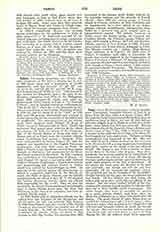

Tahiti, Vicariate Apostolic of.—Tahiti, the most important of the Society Islands, has an area of 600 square miles and a population of 11,691 inhabitants, and lies between 17° 29′ 30″ and 17° 47′ S. lat. and 151° 29′ 53″ and 151° 56′ W. long. It was discovered by Wallis in 1757. This honor is also claimed for Fernandez Quiros, the pilot of the Mendana expedition from Peru to the Philippines, about 1600. Bougainville, Cook, and other explorers made Tahiti famous in Paris as “La Nouvelle Cythere”, and in London aroused an enthusiasm for “the lovely isle”, which led to the formation, by Dr. Haweis and others, of the London Missionary Society in 1794-95, and the despatch of the “Duff” in 1796 with some 60 persons, missionaries and teachers of trades and crafts, for the conversion of the island and its neighbors. The representatives of the society made little progress until Pomare II, King of Tahiti, accepted Protestantism in 1815. Under his successors they gained great influence in the island government. In 1836 two priests of the Congregation of the Sacred Hearts of Jesus and Mary of Picpus arrived in Tahiti from the Gambier Islands, where Catholicism had gained a foothold. They were twice expelled by Queen Pomare IV, with the support and approbation of the English Protestant missionaries, and took their cause to Paris. In 1838 a French naval expedition exacted from Queen Pomare an indemnity and guarantees for the future for French residents in the island. In 1841 a mission was established by the Congregation of Picpus. In 1842 Pomare IV signed a convention with Admiral Dupetit-Thouars, establishing a French protectorate and guaranteeing full religious liberty in Tahiti, which was ratified by Louis-Philippe in 1843. An uprising of the natives against the protectorate resulted in a punitive expedition by the French admiral, the flight of Queen Pomare, and the forcible expulsion from the island of Rev. W. T. Pritchard of the London Missionary Society, whom the admiral held responsible for the revolt. This act was disavowed by the French Government and an indemnity paid to Great Britain based upon the claim that Pritchard, at the time of his expulsion, had been appointed British consul.
In 1848 Tahiti with its dependent islands was detached from the Vicariate of the Marquesas, and placed under the able and scholarly Msgr. Jaussen. In 1880 King Pomare, with the consent of the French Chambers, proclaimed Tahiti an integral part of the French Republic. In 1887 the French Government secularized the schools. Upon the death of Msgr. Jaussen in 1891 Msgr. Verdier, his assistant since 1884, succeeded to his labors, made doubly difficult by the sectarian missions and the attitude of French officials. Since 1903 the various groups of French islands in Oceania, exclusive of New Caledonia and its dependencies, have been united in one homogeneous colonial establishment, administered from Tahiti by a governor and privy council, with an administrative council. The present Vicariate of Tahiti covers the Society group, the Leeward and Gambier Islands, the Tuamotu group, Tubuai and Rapa, all belonging to France; the Cook and Penrhyn Islands, annexed to New Zealand in 1902; Pitcairn (unattached) and Easter Island, belonging to Chile. The Mission consists of: 1 bishop (Msgr. Hermel, whose residence is at Papeete, the chief town of Tahiti), 1 coadjutor with right of succession, 30 priests and several brothers of the Congregation of Picpus; 6 brothers of Ploermel; 12 churches with resident pastors; 50 other churches and chapels; 24 Sisters of St. Joseph of Cluny; 1 boys’ school; 1 girls’ school; 20 parochial schools; 2 hospitals. The total population of the vicariate is estimated at 31,000 inhabitants, with 7700 Catholics.
W. F. SANDS

